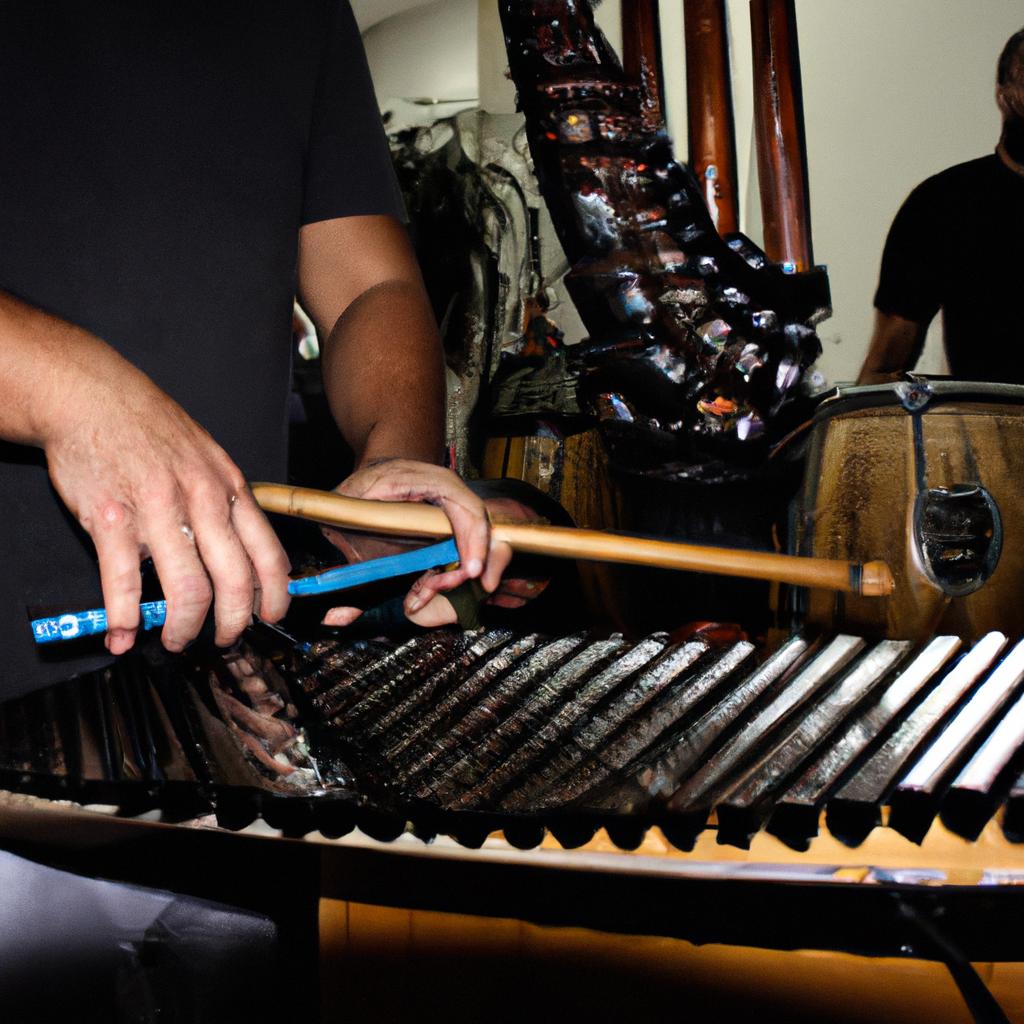Songs in the Context of Arts and Entertainment: The Music Experiences

The significance of songs in the realm of arts and entertainment cannot be overstated. Songs have the power to evoke emotions, tell stories, and create connections among individuals across different cultures and backgrounds. They serve as a universal language that transcends barriers and engages listeners on an emotional level. For instance, consider a hypothetical scenario where a classical music piece is performed at a prestigious concert hall. As the orchestra plays, the audience becomes captivated by the intricate harmonies and melodies, feeling a range of emotions from joy to sadness. The experience exemplifies how songs can transport us into a world beyond words, inviting us to explore the depths of human expression.
Songs not only hold aesthetic value but also play a crucial role in various forms of entertainment media such as films, television shows, and theatrical productions. In these contexts, songs enhance storytelling by conveying themes, character development, or setting moods within specific scenes. For example, in a popular film musical like “La La Land,” songs are integrated seamlessly into the narrative structure to express characters’ desires and dreams while advancing the plot. Through this integration, audiences become emotionally invested in the storylines unfolding before them – singing along with familiar tunes or being moved by powerful ballads that resonate deeply within their hearts.
In In addition to their emotional impact, songs also serve as a means of cultural expression and social commentary. They can reflect the values, beliefs, and experiences of a particular community or society, providing a platform for artists to address important issues or advocate for change. For instance, protest songs have historically played a significant role in various movements such as civil rights, anti-war activism, and gender equality. These songs not only raise awareness but also inspire collective action by rallying individuals around a common cause.
Furthermore, songs have the power to create lasting memories and associations in our lives. We often associate specific songs with significant moments or periods in our personal histories. Whether it’s a song that reminds us of falling in love, an anthem that empowers us during challenging times, or a tune that transports us back to our childhoods – these musical connections hold immense sentimental value and contribute to the rich tapestry of our individual identities.
Overall, the significance of songs in the realm of arts and entertainment lies in their ability to move us emotionally, convey powerful narratives, connect people across cultures, facilitate cultural expression and social change, and create lasting memories. Songs are an integral part of human experience – enriching our lives through their beauty, resonance, and capacity to transcend boundaries.
The Role of Songs in Film and Television
Songs play a significant role in enhancing the overall experience of watching films and television shows. They have the power to evoke emotions, set the tone, and highlight key moments within a narrative. For instance, imagine a scene in a movie where the protagonist experiences heartbreak after being betrayed by their loved one. The use of a melancholic song during this particular moment can intensify the emotional impact on viewers, drawing them deeper into the story.
Incorporating music into visual media can be achieved through various means. One common approach is to feature popular songs that are already familiar to audiences. These well-known tracks often resonate with viewers due to personal connections they may have formed with those songs over time. Consequently, when such songs are strategically placed within film or television scenes, they elicit a sense of nostalgia or familiarity among audience members, thus strengthening their engagement with the narrative.
To further illustrate the significance of songs in film and television, consider the following bullet points:
- Music enhances suspense: By using intense soundtracks or rhythmic beats during action sequences or climactic moments, filmmakers create tension and heighten anticipation.
- Songs as character development tools: Through carefully selected lyrics and melodies, songs can reveal insights into characters’ personalities, desires, or inner struggles.
- Musical motifs for continuity: Repetition of specific musical themes throughout a film or TV series helps establish an audio identity for recurring characters or settings.
- Emotional cues through genre-specific choices: Different genres employ distinct types of music (e.g., classical orchestral scores in period dramas) to enhance storytelling elements like romance or adventure.
Additionally, incorporating tables into academic writing provides a visually engaging way to organize information effectively. Here’s an example table showcasing instances where different genres of films utilize specific types of music:
| Genre | Type of Music |
|---|---|
| Romantic comedy | Upbeat pop/rock songs |
| Thriller | Suspenseful orchestral scores |
| Fantasy | Epic symphonic arrangements |
| Documentary | Ambient background music |
In conclusion, it is evident that songs hold a crucial role in film and television by amplifying emotions, creating connection points with viewers, and reinforcing narrative elements. The strategic use of music contributes to the overall storytelling experience, immersing audiences deeper into the fictional world being portrayed on screen.
Moving forward to the subsequent section about “Songs as a Form of Storytelling,” we can explore how lyrics and melodies intertwine with visual narratives to convey powerful messages.
Songs as a Form of Storytelling
Songs in the Context of Arts and Entertainment: The Music Experiences
Having explored the role of songs in film and television, let us now delve into another aspect of their significance – songs as a form of storytelling. To illustrate this point, consider a hypothetical scenario where a song plays a pivotal role in conveying emotions and advancing the narrative within a popular Broadway musical.
In this hypothetical case study, imagine a scene from the renowned musical “Les Misérables.” During one particular moment in Act 1, the character Fantine sings the powerful ballad “I Dreamed a Dream.” Through her heartfelt performance, she shares her despair and longing for better days amidst poverty and adversity. This emotionally charged song not only serves as an outlet for Fantine’s inner turmoil but also provides insight into her backstory and predicament. By incorporating such poignant melodies into its storytelling framework, “Les Misérables” captivates audiences on both an intellectual and emotional level.
When analyzing songs as a form of storytelling within various art forms, it is crucial to acknowledge their potential to evoke strong emotions and connect with listeners on a profound level. Consider these key aspects that contribute to their effectiveness:
- Lyricism: Powerful lyrics can encapsulate complex emotions or ideas succinctly.
- Melody: Catchy tunes have the ability to linger in our minds long after we hear them.
- Vocal delivery: Skillful performances by singers convey the intended emotions effectively.
- Musical accompaniment: Well-composed arrangements complement the lyrics and enhance the overall impact.
To further emphasize this point, let us examine how different elements work together harmoniously by considering an example from stage productions:
| Element | Purpose | Example |
|---|---|---|
| Lyrics | Express thoughts, feelings, or ideas | “Defying Gravity” from “Wicked” |
| Melody | Captivate attention and create a mood | “Memory” from “Cats” |
| Vocal delivery | Convey emotions through performance | Idina Menzel’s rendition of “Let It Go” |
| Musical accompaniment | Enhance the overall sonic experience | The orchestra in “The Phantom of the Opera” |
In conclusion, songs as a form of storytelling have the ability to convey deep emotions and enrich narratives across various artistic mediums. Through their lyrical content, melodic structure, vocal performances, and musical accompaniment, these compositions leave an indelible impact on both performers and audiences alike. As we move forward into our discussion on songs in theatre productions and how they enhance the narrative, let us explore another facet of this multifaceted art form.
Songs in Theatre Productions: Enhancing the Narrative
Building upon the notion of songs as a form of storytelling, this section explores the role of music in enhancing narratives within theatre productions. By incorporating songs into theatrical performances, artists can effectively convey emotions, deepen character development, and create a more immersive experience for the audience. To illustrate this point, let us consider a hypothetical example of a musical theater production titled “The Journey Home.”
In “The Journey Home,” the protagonist embarks on an emotional quest to find their true identity. Throughout the performance, carefully selected songs are integrated into key scenes to heighten dramatic tension and evoke powerful emotions among viewers. For instance, during a pivotal moment when the protagonist confronts their inner demons, a hauntingly beautiful ballad underscores their internal struggle and vulnerability.
To further understand how songs enhance narrative in theatre productions, we can explore some notable ways in which they contribute to the overall artistic experience:
- Emotional resonance: Songs have an innate ability to tap into human emotions. When incorporated strategically within a play or musical, they serve as conduits for connecting with audiences on a deeper level.
- Character depth: Through well-crafted lyrics and melodies, songs allow characters to express their thoughts, desires, and fears more intimately than through dialogue alone. This enables performers to showcase nuanced portrayals that resonate with the audience.
- Narrative progression: Songs often act as catalysts for moving the story forward by encapsulating important plot points or transitions. They provide opportunities for exposition while engaging listeners emotionally.
- Engaging aesthetics: The combination of music, choreography, lighting design, and set elements creates visually captivating moments onstage. These sensory experiences enrich both individual scenes and overarching narratives.
By weaving together these different elements – compelling stories, evocative melodies, vivid visuals – theatre productions harness the power of song to transport audiences into imagined worlds where emotions run high.
Transitioning seamlessly into our next topic about “Songs in Visual Arts: The Intersection of Music and Painting,” let us explore how these two art forms intersect to create multidimensional experiences that ignite our senses.
Songs in Visual Arts: The Intersection of Music and Painting
Transitioning from the previous section, where songs were explored in the context of theatre productions, we now delve into another fascinating realm where music intertwines with visual arts – paintings. This unique combination offers a multi-sensory experience that enhances both mediums and creates an immersive encounter for viewers. To illustrate this concept, let us consider the hypothetical scenario of an art exhibition featuring a collection of abstract paintings accompanied by carefully curated musical compositions.
Imagine entering a gallery filled with vibrant and thought-provoking abstract artworks, each capturing emotions and ideas through color, form, and texture. As you move closer to one particular painting, your attention is drawn to its intricate details and expressive brushstrokes. Simultaneously, soothing classical melodies begin to resonate through concealed speakers strategically placed throughout the exhibit space. The harmonies seamlessly blend with the visuals, evoking a sense of serenity as they enhance the overall aesthetic experience.
To better understand how songs can intersect with painting in such contexts, here are some key aspects to consider:
- Emotional resonance: When paired effectively, music can amplify emotional responses elicited by visual art pieces.
- Narrative enrichment: Songs can add depth to the storytelling within a painting or provide additional layers of interpretation.
- Temporal dimension: By incorporating time-based elements like rhythm and tempo, music transforms static images into dynamic experiences.
- Subjective perception: Different individuals may interpret the combined artwork differently due to their personal associations with specific musical styles or genres.
In exploring these dimensions further, it becomes evident that the marriage between music and painting brings forth new possibilities for creative expression. Artists have long recognized this potential synergy and have embraced collaborations across disciplines. From Kandinsky’s synesthetic experiments to contemporary multimedia installations, artists continue to push boundaries by merging soundscapes with visually captivating creations.
Moving forward into our next exploration of artistic realms, we will now examine the incorporation of songs in dance performances. This fusion showcases the captivating interplay between movement and melody, highlighting how music can elevate the physical expression of emotion through choreography.
[Transition sentence to subsequent section: ‘Songs in Dance Performances: The Marriage of Movement and Melody’]
Songs in Dance Performances: The Marriage of Movement and Melody
In the realm of visual arts, music has often found itself intertwined with painting, creating a unique sensory experience for viewers. One captivating example is the work “Music Lesson” by Johannes Vermeer. In this masterpiece, Vermeer masterfully portrays an intimate scene where a young woman sits at a harpsichord while her instructor leans over to guide her playing. The harmonious blend of colors and delicate brushstrokes resonates with the melodic notes that fill the room.
To better understand how songs are incorporated into visual arts, let us explore some key aspects:
- Visual Rhythm: Just as music possesses rhythm, paintings can also evoke a sense of rhythm through their composition and use of lines and shapes. This creates a rhythmic flow that mirrors the tempo and beat found within musical compositions.
- Emotional Expression: Both music and painting have the power to elicit emotions from their audience. When combined, they form a potent partnership capable of evoking even deeper emotional responses.
- Narrative Enhancement: Songs embedded within visual artworks can enhance storytelling elements by adding layers of meaning or context to the narrative depicted in the painting.
- Temporal Dimension: While paintings capture a single moment frozen in time, songs introduce an element of temporal progression. They create an illusion of movement within static visuals, thereby enriching the overall viewing experience.
Below is an example table showcasing renowned artworks where music plays a significant role:
| Artwork | Artist | Musical Influence |
|---|---|---|
| “The Starry Night” | Vincent van Gogh | Symbolism derived from “Moonlight Sonata” |
| “Sunday Afternoon…” | Georges Seurat | Inspired by classical melodies |
| “Water Lilies” | Claude Monet | Impressionistic representation of Debussy’s work |
| “The Guitarist” | Pablo Picasso | Influence of Spanish flamenco music |
As we delve deeper into the realm of art, it becomes evident that songs not only enhance visual aesthetics but also provide a multi-sensory experience. The interplay between music and painting creates an immersive atmosphere where the viewer can truly immerse themselves in both auditory and visual delights.
Transitioning to the next section about “Songs in Dance Performances: The Marriage of Movement and Melody,” we witness yet another captivating fusion of artistic expressions.
Songs in Video Games: Immersive Soundtracks for Interactive Experiences
Continuing our exploration of songs within the context of arts and entertainment, we now turn our attention to the fascinating realm of video games. In recent years, the role of music in gaming has evolved from a mere background enhancement to an integral part of the player’s experience. One striking example that exemplifies this shift is the critically acclaimed game “The Last of Us.” Developed by Naughty Dog Studios, this post-apocalyptic adventure seamlessly incorporates a captivating soundtrack that heightens emotional connections between players and the virtual world they inhabit.
One key aspect that sets video game music apart is its ability to evoke emotions and enhance immersion. The use of carefully crafted soundscapes can transport players into fantastical realms or intensify their engagement with high-stakes action sequences. To better understand how music achieves these effects, let us consider some notable characteristics:
- Dynamic Adaptability: Unlike traditional linear forms of media, video game music adapts dynamically to accommodate different gameplay situations. It responds to changes in pacing, intensity, and narrative progression.
- Emotional Resonance: By aligning specific melodies or motifs with particular characters, locations, or events, composers create powerful associations that amplify emotional responses.
- Ambient Atmosphere: Background tracks often establish immersive atmospheres in open-world games by evoking a sense of place through ambient sounds and musical textures.
- Interactivity: Music becomes an interactive element as players’ actions trigger dynamic shifts in tempo or instrumentation, reinforcing their agency within virtual worlds.
To illustrate these concepts further, let us delve into a table showcasing examples from various genres:
| Game Title | Genre | Musical Style |
|---|---|---|
| “Journey” | Adventure | Ethereal Orchestral |
| “Doom” | First-person Shooter | Heavy Metal |
| “Undertale” | Role-playing | Chiptune |
| “Final Fantasy VII” | Role-playing | Orchestral-Rock Fusion |
As we can see, each game employs a distinct musical style that complements its genre and enhances the player’s experience. These examples highlight the dynamic nature of video game music and its ability to evoke emotions while contributing to the overall immersive quality of interactive entertainment.
In conclusion, songs in video games have evolved from being mere background elements to becoming integral components of players’ experiences. Through their adaptability, emotional resonance, ambient atmosphere, and interactivity, video game soundtracks enhance immersion and evoke powerful emotional responses. As gaming continues to push boundaries in storytelling and technology, so too does the artistry behind its music. The marriage of gameplay mechanics with carefully crafted melodies demonstrates how this medium has become an exciting frontier for both musical composition and interactive storytelling alike.





